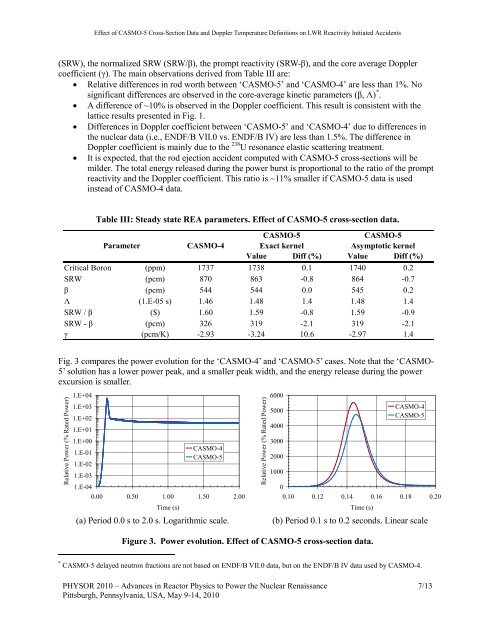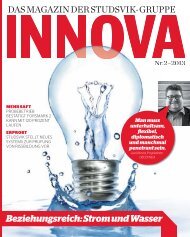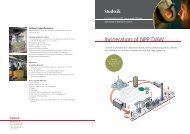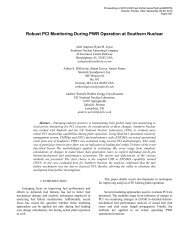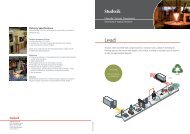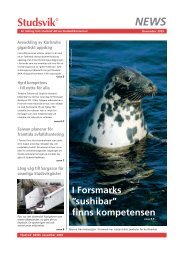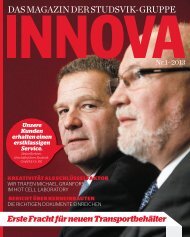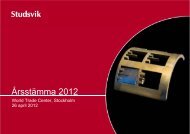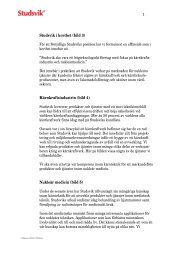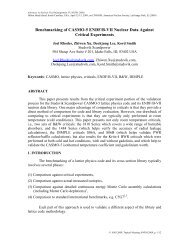Effect of CASMO-5 Cross-Section Data and Doppler ... - Studsvik
Effect of CASMO-5 Cross-Section Data and Doppler ... - Studsvik
Effect of CASMO-5 Cross-Section Data and Doppler ... - Studsvik
Create successful ePaper yourself
Turn your PDF publications into a flip-book with our unique Google optimized e-Paper software.
<strong>Effect</strong> <strong>of</strong> <strong>CASMO</strong>-5 <strong>Cross</strong>-<strong>Section</strong> <strong>Data</strong> <strong>and</strong> <strong>Doppler</strong> Temperature Definitions on LWR Reactivity Initiated Accidents(SRW)-re average <strong>Doppler</strong>. The main observations derived from Table III are: Relative differences in rod worth between ‘<strong>CASMO</strong>-5’ <strong>and</strong> ‘<strong>CASMO</strong>-4’ are less than 1%. Nosignificant differences are observed in the core- * . A difference <strong>of</strong> ~10% is observed in the <strong>Doppler</strong> coefficient. This result is consistent with thelattice results presented in Fig. 1. Differences in <strong>Doppler</strong> coefficient between ‘<strong>CASMO</strong>-5’ <strong>and</strong> ‘<strong>CASMO</strong>-4’ due to differences inthe nuclear data (i.e., ENDF/B VII.0 vs. ENDF/B IV) are less than 1.5%. The difference in<strong>Doppler</strong> coefficient is mainly due to the 238 U resonance elastic scattering treatment. It is expected, that the rod ejection accident computed with <strong>CASMO</strong>-5 cross-sections will bemilder. The total energy released during the power burst is proportional to the ratio <strong>of</strong> the promptreactivity <strong>and</strong> the <strong>Doppler</strong> coefficient. This ratio is ~11% smaller if <strong>CASMO</strong>-5 data is usedinstead <strong>of</strong> <strong>CASMO</strong>-4 data.Table III: Steady state REA parameters. <strong>Effect</strong> <strong>of</strong> <strong>CASMO</strong>-5 cross-section data.Parameter<strong>CASMO</strong>-4<strong>CASMO</strong>-5<strong>CASMO</strong>-5Exact kernelAsymptotic kernelValue Diff (%) Value Diff (%)Critical Boron (ppm) 1737 1738 0.1 1740 0.2SRW (pcm) 870 863 -0.8 864 -0.7 (pcm) 544 544 0.0 545 0.2 (1.E-05 s) 1.46 1.48 1.4 1.48 1.4 ($) 1.60 1.59 -0.8 1.59 -0.9 (pcm) 326 319 -2.1 319 -2.1 (pcm/K) -2.93 -3.24 10.6 -2.97 1.4Fig. 3 compares the power evolution for the ‘<strong>CASMO</strong>-4’ <strong>and</strong> ‘<strong>CASMO</strong>-5’ cases. Note that the ‘<strong>CASMO</strong>-5’ solution has a lower power peak, <strong>and</strong> a smaller peak width, <strong>and</strong> the energy release during the powerexcursion is smaller.Relative Power (% Rated Power)1.E+041.E+031.E+021.E+011.E+001.E-011.E-021.E-031.E-040.00 0.50 1.00 1.50 2.00Time (s)<strong>CASMO</strong>-4<strong>CASMO</strong>-5(a) Period 0.0 s to 2.0 s. Logarithmic scale.(b) Period 0.1 s to 0.2 seconds. Linear scaleFigure 3. Power evolution. <strong>Effect</strong> <strong>of</strong> <strong>CASMO</strong>-5 cross-section data.Relative Power (% Rated Power)60005000400030002000100000.10 0.12 0.14 0.16 0.18 0.20Time (s)<strong>CASMO</strong>-4<strong>CASMO</strong>-5* <strong>CASMO</strong>-5 delayed neutron fractions are not based on ENDF/B VII.0 data, but on the ENDF/B IV data used by <strong>CASMO</strong>-4.PHYSOR 2010 – Advances in Reactor Physics to Power the Nuclear RenaissancePittsburgh, Pennsylvania, USA, May 9-14, 20107/13


